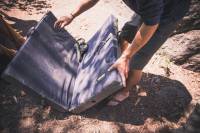Climbing in Squamish? Geologists Predict More Rockfall
Climbers reported rockfall near Squamish’s Photophobia Buttress earlier this week. This winter, extreme fluctuations in weather and rising temperatures could make for more rockfall in the valley — and elsewhere.
2021 was a historic year for rockfall in British Columbia’s Squamish Valley. The first notable reports of formation failures, which wiped out a climbing route on the Grand Wall, surfaced in June. In July, a significant collapse sheared several pitches off the Chief and annihilated “dozens of 30-meter trees” at its base, Gripped reported.
Rockfall, small and large, continued through the fall and early winter. In November, the fifth major collapse occurred at Photophobia Buttress, not far from this week’s event.
As the bitter winter weather gives way to warmer spring temps, things could get sketchy. According to a geologist familiar with the conditions around Squamish, last year’s series of rockfalls were likely due to climate change.
Extreme precipitation followed by intense heat cycles causes the rock to expand and contract at perversely rapid rates. Those wild fluctuations often create fractures in the formation, which can cause parts of it to shed off as rockfall.
The heavy snowfall and potential extreme swings in temperature could lead to another year of increased rockfall throughout Squamish and other mountainous areas in the Northern Hemisphere.
Anyone who plans to spend time in a potential rockfall zone should take protective measures and understand the additional risks caused by rapidly changing weather.

Mitigating Rockfall Risk
Squamish isn’t the only climbing area that could be affected. Increasing shifts in temperature and humidity are not unique to that region. These natural events, coupled with an explosion in outdoor recreation’s popularity, boost the odds of rockfall-related accidents.
There are a few measures that you can take to help mitigate the risk:
-
Wear your climbing helmet for the duration of your climbing session.
Whether you’re climbing, belaying, cracking open a crag beer, or taking a leak — if you’re near a rock formation that’s taller than you are, wear a helmet, even if that means wearing it from car to car. -
Have a way to contact help immediately.
Do you have a reliable cell signal at the crag? If not, invest in an emergency radio or signal booster. -
Know the location of emergency resources available near where you’re climbing.
Where’s the closest ranger station? Hospital? -
Keep your wilderness first-aid kit stocked with a splint, bleed stop, ACE wrap, and a tourniquet.
Yes, you can use branches to stabilize an injury, but locating an adequate one can waste time. Having a clean splint at the ready doesn’t. -
Consider leaving pets at home.
They didn’t sign up for our risky hobby; we did. We have the advantage of knowing the risks. We also have the benefit of protective equipment. (I didn’t think much about this until I saw a dog get wiped out by limestone rockfall while its owners climbed a nearby route. “Devastating” doesn’t begin to describe the situation.)
Apart from avoiding a crag altogether (which, in some cases, is the best option), there’s no way to guarantee absolute safety from shedding rocks.
But maintaining hyper vigilance about the protective measures you take and being knowledgeable about your surroundings can significantly reduce the odds that rockfall will implicate you.
The post Climbing in Squamish? Geologists Predict More Rockfall appeared first on GearJunkie.

